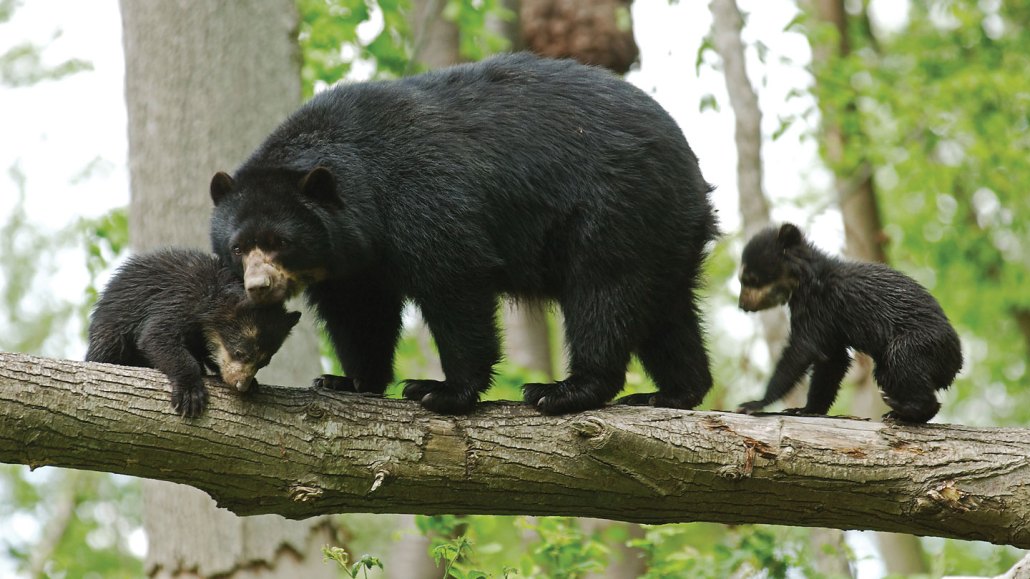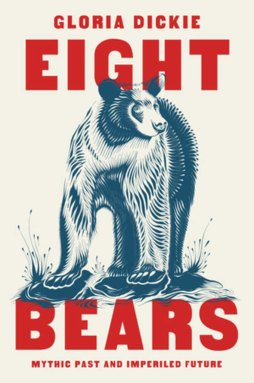
The spectacled bear of South America faces an uncertain future as climate change threatens to destroy its forest home in the Andes.
slowmotiongli/iStock/Getty Images Plus

Eight Bears
Gloria Dickie
W.W. Norton & Co., $30
Bears have long been considered family. “Stories of a familial bear exist in almost every human culture that shares territory with the animal,” writes journalist Gloria Dickie in her new book, Eight Bears.
The Yakut people of eastern Siberia call brown bears “grandfather” and “uncle.” Shepherds in the French Pyrenees call the brown bear la va-nu-pieds, the “barefooted one,” a reference to its humanlike footprints. In Peru, the Ukuku is an Andes-traipsing man-bear hybrid in Quechua lore that steals away young women.
The ancient and recurrent history of humans recognizing bears as either spiritual or biological brethren sets the tone for the book, which provides rich lessons for understanding our ursine neighbors and how their lives have intertwined with our own.
That bears have had such a cultural grip on our species is impressive given their dearth of global diversity. As you might have guessed, there are only eight bear species: brown, black, sun, moon, polar, spectacled, sloth and giant panda. Dickie explores each in vivid detail, traveling across three continents to some of the places where they amble.
The settings Dickie presents — some remote, some urban — are marvelously rendered. She transports readers to the perilously steep ridgelines of the Andes, perpetually misty and buzzing with hummingbirds, and to Churchill, Canada, a subarctic town on an icy seashore sitting square in the path of migrating polar bears (SN: 11/1/22). Through these travels, Dickie weaves in each species’s unique stories — of decline, recovery and an uncertain future — and how humans have roped their own desires and ambitions to the bears, for better or worse.
Dickie expertly peppers her “ursine odyssey” with dry humor, augmenting the experience of encountering the bears, which oscillates from dopey to truly dangerous. One moment that stands out is when Dickie is preparing to visit the forest homes of Indian sloth bears and describes digesting jarringly matter-of-fact stories and photos of the aftereffects of maulings. But not to worry, a local biologist assures her “in a way that was meant to be comforting,” she will see more injuries like this where she is set to travel.
Such engaging insights into Dickie’s experiences elevate Eight Bears well above a patchwork of bear facts.
Though, there are facts aplenty. Dickie provides ample context on each species’s biology, ecology and historical (and sometimes prehistorical) relationship with humans. The robust accounting of so much about these animals is fascinating, though some forays into the evolutionary history of each branch of the bear family tree and the taxonomic identity of Paddington Bear and Baloo from The Jungle Book can feel meandering (SN: 4/3/16). Still, Dickie excels in crafting a captivating and carefully considered mosaic of stories that will engross any reader interested in wildlife and wilderness.
One primary theme in Eight Bears is that many species inhabit woefully shrinking natural spaces. In the Andes, spectacled bears’ cloud forests risk ascending upslope into oblivion due to a warming climate. Polar bears are caught between rapidly dwindling sea ice and a genetic tidal wave from hybridizing with brown bears that have started wandering poleward (SN: 9/3/20). Sloth bears are squeezed into smaller and smaller pockets of forest as human populations expand, leading to violent, tragic conflicts with people.
These eight bear species, Dickie shows, manage to capture the full range of people’s attitudes toward wilderness, from awe to exploitation, neglect to reverence. She illuminates radically varied consequences of humans placing political, social or economic value on bears. For instance, circumstances aligned for giant pandas to be useful in “panda diplomacy” as a political bargaining chip for China, thus feeding a cultural status and conservation investment the seven other bear species lack. Dickie’s honest and bleak accounts of moon and sun bears languishing on farms in Vietnam that collect bear bile to treat inflammation and high cholesterol present a far darker reality for some species.
There are relative success stories in which bears have bounced back into abundance, but that can present ongoing tension. In the United States, humans and black bears navigate coexistence at the wildland-urban interface (and national park trash cans). On the eastern flanks of the Rockies, brown bears lollop into territories gone bearless for decades due to intentional extermination, now saturated with farms and people.
In the end, Dickie warns that only three species — black, brown and panda bears — seem well-positioned to persist in the wild in the future. Losing animals whose lives have so closely paralleled our own would be like losing family, she writes. “And in some ways, we would lose a part of our own wildness. Without bears, the woods, and our stories, would be empty.”
Buy Eight Bears from Bookshop.org. Science News is a Bookshop.org affiliate and will earn a commission on purchases made from links in this article.






